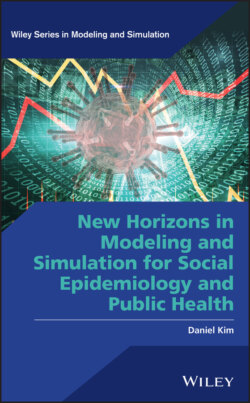Читать книгу New Horizons in Modeling and Simulation for Social Epidemiology and Public Health - Daniel Kim - Страница 16
1.4 The 3 P's (people, places, and policies) Population Health Triad
ОглавлениеImplicit in this conceptualization of the social determinants of health is that more upstream population characteristics, places, and policies matter to population health. Jointly, we can refer to these three factors that are pivotal to population health as the “3 P's” (people, places, and policies) Population Health Triad (Figure 1.3). The classic Host–Agent–Environment epidemiologic triad posits that a susceptible host, an external agent, and an environment are needed to produce disease. Similarly, both places and policies interact with populations to manifest disease. For example, neighborhoods where we live can influence our health through physical and material characteristics such as air quality, access to nutritious foods and opportunities for leisure and exercise, health services, and education/schools and employment opportunities (Braveman et al. 2011). Policies in nonhealth sectors (e.g. transportation, education, and housing) can also intersect with and shape health. Social policies such as those that affect levels of welfare spending and tax policies that determine the rich–poor gap have plausible linkages to the social environment, health behaviors, and individual health and disease endpoints. Reciprocal interactions are also possible, with populations being able to shape both policies and places, such as by mobilizing together through social capital (e.g. political activism) to effect change (Figure 1.2).
Figure 1.3 The 3 P's (people, places, and policies) Population Health Triad.
To help address the social determinants of health at a government level, in 2010, the WHO and the Government of South Australia (2010) developed the HiAP approach through the Adelaide Statement on HiAP. In this comprehensive population health strategy, health considerations in policymaking permeate and encompass multiple public sectors that may influence health, such as transportation, agriculture, housing and urban development, and education (Figure 1.4). The HiAP approach was founded on the notion that many social determinants of health are outside the purview of public health agencies. The roots of this radical approach can be traced back to the seminal ideas put forth in the Alma Ata Declaration on Primary Health Care (1978) and the Ottawa Charter for Health Promotion (1986). The HiAP approach became reinforced in the 2011 Rio Political Declaration on Social Determinants of Health (World Health Organization 2016a).
Figure 1.4 Examples of multiple public sectors collectively adopting a Health in All Policies (HiAP) approach.
The HiAP approach has been increasingly adopted in jurisdictions around the world. For example, the Department of Housing and Urban Development (HUD) in the United States has embraced a HiAP approach and is collaborating with the U.S. Department of Health and Human Services (HHS) to ensure the integration of the elderly and disabled into the community via housing and human service agencies to enable them to live as long and as healthily as possible (Bostic et al. 2012). HUD further encourages applicants to regional planning and neighborhood initiative grants to incorporate health metrics into their baseline assessments of neighborhoods and asks them to indicate how they will support regional planning efforts that consider public health impacts (Bostic et al. 2012). Moreover, to attain objectives on the social determinants of health, the HiAP approach has been encouraged by Healthy People 2020 (2010), the U.S. Centers for Disease Control and Prevention initiative that establishes national goals and objectives for policy, programs, and activities to address the major health challenges facing our country today. The Secretary's Advisory Committee on Healthy People Objectives for 2020 (Office of Disease Prevention and Health Promotion 2010) has further advised that all federal agencies (e.g. the Departments of Education, Transportation, and HUD) should be required to include Healthy People in their strategic plans.
In 2010, the US state of California created a HiAP Task Force, with representation of 19 state agencies, offices, and departments. Employing a HiAP framework, this statewide effort brought policymakers together to identify and recommend programs, policies, and strategies to improve health, including multiagency initiatives addressing transportation, housing, affordable healthy foods, safe neighborhoods, and green spaces. Additional recommendations included the development of health criteria in the discretionary funding review process and incorporating health issues into statewide data collection and survey efforts (Health in All Policies Task Force 2010).
The region of South Australia has also implemented the HiAP approach. Its HiAP model is based on the twin pillars of central governance and accountability and a “health lens” analysis process, which aims to identify key interactions and synergies between South Australia's Strategic Plan (SASP) targets, policies, and population health (Kickbusch and Buckett 2010). Notably, it was in Adelaide, the capital of South Australia, that the 2010 Adelaide Statement of HiAP was first developed. The South Australian Public Health Act was developed during the early implementation stages of HiAP and provided a legislative mandate to allow HiAP approaches to be systematically adopted across state and local governments within the region (Delany et al. 2015).
To strengthen the overall accountability for the HiAP pledges made by countries in the 2011 Rio Political Declaration on Social Determinants of Health, the WHO is currently developing a global monitoring system for intersectoral interventions on the social determinants of health to improve health equity (World Health Organization 2016b).
